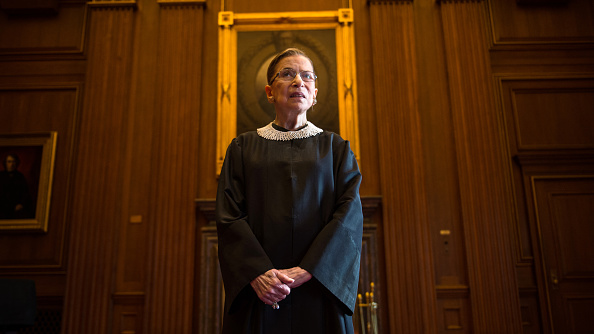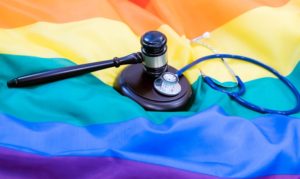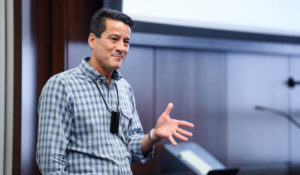
Justice Ginsburg paved the way toward gender equality, inspiring generations to advocate justice under the law.
Justice Ruth Bader Ginsburg changed the world—but she especially changed the world for women like us who are at the earliest stages of their legal careers.
When Justice Ginsburg entered Harvard Law School in 1956, women accounted for less than 3 percent of the legal profession in the United States. Only one woman, Florence Ellinwood Allen, had ever served on an Article III appellate court. It would be another ten years before Constance Baker Motley became the first Black woman nominated to a federal judgeship.
Justice Ginsburg was one of just nine women in her law school class of 552. At a dinner party, the then-dean of Harvard Law School asked each woman in turn why she was occupying a seat that could be held by a man.
While Justice Ginsburg studied for her law degree, hundreds of laws codified strict gender roles for women and men in all facets of life. Employers could demote a woman or terminate her employment if she became pregnant. Employers could also decline to hire women in the first place, as Justice Ginsburg discovered upon graduating.
Case by case, through persistent, careful lawyering, Justice Ginsburg chipped away at laws that reified sex stereotypes and permitted differential treatment on the basis of sex.
As an advocate at the American Civil Liberties Union’s Women’s Rights Project, she helped persuade the all-male U.S. Supreme Court to extend the U.S. Constitution’s equal protection guarantee to women in the landmark case Reed v. Reed, challenging a law that established an automatic preference to men to be appointed administrators of a deceased person’s estate. Following Reed, Congress changed hundreds of laws that overtly classified people on the basis of sex.
As a lawyer, Ginsburg also helped develop the legal strategy of contesting laws that treated men and women differently by bringing cases on behalf of men who were disadvantaged under those laws—showing that differential gender-based treatment harms everyone.
In Weinberger v. Wiesenfeld, Ginsburg successfully objected to a provision in the Social Security Act that denied benefits to widowed fathers, despite affording those benefits to widowed mothers. Her argument in Califano v. Goldfarb led the Court to reject “archaic and overbroad” generalizations that a woman is more likely to depend on her spouse than a husband on his spouse. In Frontiero v. Richardson, she convinced the Court to hold invalid federal statutes that presumed a serviceman’s wife, but not a servicewoman’s husband, is “dependent,” establishing that married partners must be granted the same benefits regardless of gender.
Justice Ginsburg’s efforts as a lawyer advocating for gender equality were instrumental to the passage of the Pregnancy Discrimination Act of 1978, which established that pregnancy discrimination in the workplace is unlawful sex discrimination.
After joining the Supreme Court, Justice Ginsburg wrote the majority opinion in United States v. Virginia. The Court held that the Virginia Military Institute’s refusal to admit women violated the Equal Protection Clause—barring gender discrimination on the basis of stereotypes of ability and preference.
When the Court upheld strict time limits for bringing workplace discrimination suits in Ledbetter v. Goodyear, Justice Ginsburg used her dissent to call on Congress to change the law. Less than two years later, Congress passed the Lilly Ledbetter Fair Pay Act of 2009.
The cases that Justice Ginsburg argued as a legal advocate have served for decades as the foundation for the legal analysis of sex-based discrimination and the continued fight for equality under the law. She paved the way for women and helped lay the groundwork for the legal recognition of trans, nonbinary, and gender-nonconforming people.
Justice Ginsburg helped to ensure that the next generation of law students, our generation, would not encounter the same barriers in their lives or in the pursuit of their legal education that she had encountered. Yet as she knew, society is far from finished with the fight for justice and equality.
She understood that “real change, enduring change, happens one step at a time.” Even when she was on the losing side of an argument, she wrote her striking dissents to shape the future. In Burwell v. Hobby Lobby, for example, Justice Ginsburg insisted that allowing for-profit corporations to opt out of providing their employees with insurance coverage for contraceptive care only burdens those employees’ exercise of control over their reproductive health.
With all that Justice Ginsburg did to advance justice and equality, we deeply mourn her passing. We also see the need to reflect on how we can forge ahead.
Today, women make up half, or more than half, of the students attending law schools throughout the United States. But the U.S. legal profession has not been equalized.
Barely one-fifth of state court judges are women, and only 8 percent of all state court judges are women of color. Although women make up nearly half of all associates in private law practice, they hold only about 12 percent of the highest positions within law firms.
In recent years, 17 percent of lawyers who argued in front of the Supreme Court were women. Over half of all judicial clerks are women. Yet clerks at the Supreme Court remain mostly white and male. Women are also underrepresented as general counsels, law school administrators, and law review editors. On average, women lawyers are still paid less than their male counterparts.
Our generation will work to promote access to education, not just for women, but for all people who have previously had those opportunities foreclosed. Our work will need to be different, because the current struggles for equality in education and the legal profession are different.
Perhaps women outnumber men in some law school classrooms, but which students feel most comfortable raising their hands? When we say “women,” are we referring to all women? Or are the experiences of women of color and transwomen excluded or denied?
Until we address these questions, and in doing so, until we confront and eradicate both explicit bigotry and implicit biases, access to education will never be “equal.” As women and law students, we stand on the foundation that Justice Ginsburg laid for us. It is our turn to pave the way for those who will come after us. We thank Justice Ginsburg for all she has done to make it possible to continue to fight for justice.



